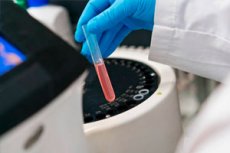New publications
Markers that can recognize the approach of myocardial infarction have been discovered
Last reviewed: 29.06.2025

All iLive content is medically reviewed or fact checked to ensure as much factual accuracy as possible.
We have strict sourcing guidelines and only link to reputable media sites, academic research institutions and, whenever possible, medically peer reviewed studies. Note that the numbers in parentheses ([1], [2], etc.) are clickable links to these studies.
If you feel that any of our content is inaccurate, out-of-date, or otherwise questionable, please select it and press Ctrl + Enter.

The molecular composition of blood can be used to determine the risks of myocardial infarction in the next six months.
Infarction occurs against the background of a sharp disturbance of blood circulation in the coronary vascular network responsible for blood flow in the myocardium. Such a condition is provoked by narrowing of the lumen of blood vessels - for example, due to blockage by atherosclerotic layers, or as a result of severe stress. There is no single cause-and-effect relationship, but scientists are convinced that intense psycho-emotional stress significantly increases the risk of heart attack.
The stress factor triggers neuro-hormonal processes that affect blood circulation. And a heart attack turns out to be just a consequence of already triggered reactions.
Be that as it may, a heart attack doesn't come out of nowhere and can probably be predicted. How can a blood test help in such a case?
Stress, metabolic factors can be recognized by the molecular composition of the blood. The main thing is to know which molecules to pay attention to. Experts have identified such molecules that can "declare" a possible heart attack 5-10 years before the attack.
Representatives of the Swedish University (Uppsala) together with Norwegian, Italian, French, Estonian colleagues have searched for similar markers capable of recognizing the approach of a heart attack as early as possible - for example, several months before the attack. The scientists concluded that the pathologic pathway is often quite short: dangerous narrowing of the vascular lumen can occur quite quickly. In order to find probable short-term markers, experts examined the blood picture of several thousand patients - representatives of different countries in Europe. The participants were not known to have any heart problems. However, more than four hundred of them had a heart attack within six months after the experiment.
Researchers compared eight hundred protein substances and more than a thousand metabolites in blood tests from patients with and without a heart attack. As a result, 48 protein substances and 43 metabolites associated with a high risk of developing a heart attack over the next six months were identified. The brain na-uretic peptide score, a substance that is produced by atrial structures when the myocardium is overstretched, plays a particular role in "prediction".
It is important for scientists not just to find molecules "involved" in heart attack. It is necessary to define such a methodology for their detection, which would be both qualitative and affordable. With this in mind, experts are conducting more and more research, improving them and opening up more and more new opportunities for cardiologists.
Details of the study can be found on the journal page nature cardiovascular research
